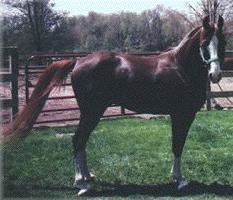 | ||
species and six of living. In the and this family comprises, tapirs and the rhinoceroses , the toed hoofed mammals, or perissobactyls. living members of the genus Equus are about 60 breeds of domesticated horses and their wild relatives. The TARPAN (E.caballus); the Asian ONAGER ; the Ass ; the three species of ZEBRA . The QUAGGA is an extinct representative . The earliest type of horse, the hyracotherium or Eohippus , lived in some 45 to 50 million years ago, during the EOCENE EPOCH . The size varied from 10 to 20 in. high ; they had four toes on each foot and three toes on each hind foot. They lived in the region that is now the Great Plains of North America, where most of the main evolutionary developments took place. Although similar animals lived in the old world at the same time, they became extinct, and to the North American Eohippus , migrating to Asia by land bridges , became the ancestor of the old world horse . The major changes were an increase in size , adaptation of teeth for grazing on grasses rather than browsing on forage, and a one toed foot. About the time when Indians reached North America , horses mysteriously became extinct there neither the ice age, competition for food , nor the appearance of a predacious Carnivora explains their disappearance; a plague could of been a possibility. Stone Age man from the old world, used horses as a food source and hunted down, as editors has shown by the bones found at various archaeological digs. They were first domesticated by nomads of Central Asia c. 2500 B.C.; by and thousand B.C. they were being used throughout the temperate zone of the Eastern Hemisphere. The horses were first used in hunting; there influence on history is incalculable. Horseracing was practiced in ancient Greece and carry races were popular events during the Roman Empire. The chariot was followed by a wide range of horse drawn vehicles. Rider's of horses rode bareback and on soft cloths before the saddle and the stirrup was invented . The breeds of today are descended from various wild progenitors , most likely the wild forest loss of Europe, a heavy variety also called the northern or Norwegian dun, and also the swifter and more slender Oriental horses (Arab and Turk). Modern ponies, of which the most popular is the Shetland, are believed to have descended from the Celtic pony. Of the Middle Ages the large and and powerful great horses were bred from the northern dun to carry armed knights; the precursor of the modern draft breeds , which superseded for farm work in the 19th century. The best known draft horse of England is the shire . Another English draft horse is the Suffork which is lighter . Horse terminology is as follows : A male as a stallion or , if castrated , a gelding; a female is a mare; her offspring foals the males called colts and the females fillies. The measuring standard of height is the hands which equals 4 in.. |
|
| ||
Need more info type in animal name then put info at the end Need more pictures type in animal name then put pics at the end | ||
